Sociology Essay: Critical Analysis of SDG 6 and Sanitation in India
VerifiedAdded on 2022/08/25
|10
|2590
|24
Essay
AI Summary
This sociology essay critically examines India's progress toward achieving Sustainable Development Goal 6, specifically Target 2, which aims to ensure access to adequate and equitable sanitation and hygiene for all by 2030. The essay delves into the historical, cultural, and structural factors that have hindered sanitation efforts in India, including inadequate water supply, cultural practices, poverty, and lack of awareness. It analyzes the impact of these factors, particularly on vulnerable populations such as women and girls in rural areas. The essay also discusses the government's initiatives, such as the Swachh Bharat Mission, and assesses their effectiveness in promoting sanitation and hygiene. It concludes that while progress is being made, India faces significant challenges in achieving SDG 6 by the target date and emphasizes the need for sustained efforts to address the root causes of sanitation issues, including behavioral change and improved infrastructure.

Running Head: Sociology
Sociology
University Name
Name of Student
Author Note
Sociology
University Name
Name of Student
Author Note
Paraphrase This Document
Need a fresh take? Get an instant paraphrase of this document with our AI Paraphraser
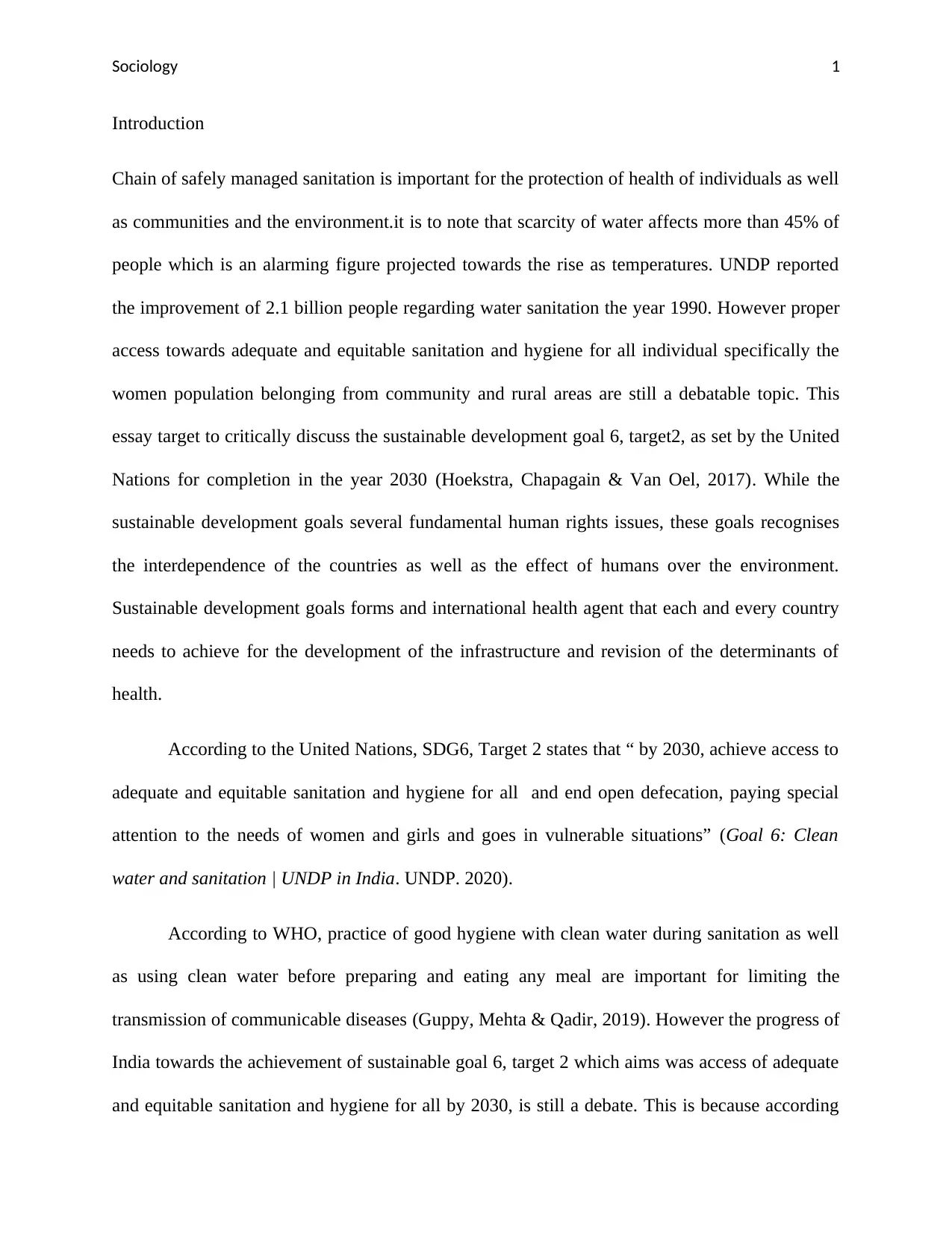
Sociology 1
Introduction
Chain of safely managed sanitation is important for the protection of health of individuals as well
as communities and the environment.it is to note that scarcity of water affects more than 45% of
people which is an alarming figure projected towards the rise as temperatures. UNDP reported
the improvement of 2.1 billion people regarding water sanitation the year 1990. However proper
access towards adequate and equitable sanitation and hygiene for all individual specifically the
women population belonging from community and rural areas are still a debatable topic. This
essay target to critically discuss the sustainable development goal 6, target2, as set by the United
Nations for completion in the year 2030 (Hoekstra, Chapagain & Van Oel, 2017). While the
sustainable development goals several fundamental human rights issues, these goals recognises
the interdependence of the countries as well as the effect of humans over the environment.
Sustainable development goals forms and international health agent that each and every country
needs to achieve for the development of the infrastructure and revision of the determinants of
health.
According to the United Nations, SDG6, Target 2 states that “ by 2030, achieve access to
adequate and equitable sanitation and hygiene for all and end open defecation, paying special
attention to the needs of women and girls and goes in vulnerable situations” (Goal 6: Clean
water and sanitation | UNDP in India. UNDP. 2020).
According to WHO, practice of good hygiene with clean water during sanitation as well
as using clean water before preparing and eating any meal are important for limiting the
transmission of communicable diseases (Guppy, Mehta & Qadir, 2019). However the progress of
India towards the achievement of sustainable goal 6, target 2 which aims was access of adequate
and equitable sanitation and hygiene for all by 2030, is still a debate. This is because according
Introduction
Chain of safely managed sanitation is important for the protection of health of individuals as well
as communities and the environment.it is to note that scarcity of water affects more than 45% of
people which is an alarming figure projected towards the rise as temperatures. UNDP reported
the improvement of 2.1 billion people regarding water sanitation the year 1990. However proper
access towards adequate and equitable sanitation and hygiene for all individual specifically the
women population belonging from community and rural areas are still a debatable topic. This
essay target to critically discuss the sustainable development goal 6, target2, as set by the United
Nations for completion in the year 2030 (Hoekstra, Chapagain & Van Oel, 2017). While the
sustainable development goals several fundamental human rights issues, these goals recognises
the interdependence of the countries as well as the effect of humans over the environment.
Sustainable development goals forms and international health agent that each and every country
needs to achieve for the development of the infrastructure and revision of the determinants of
health.
According to the United Nations, SDG6, Target 2 states that “ by 2030, achieve access to
adequate and equitable sanitation and hygiene for all and end open defecation, paying special
attention to the needs of women and girls and goes in vulnerable situations” (Goal 6: Clean
water and sanitation | UNDP in India. UNDP. 2020).
According to WHO, practice of good hygiene with clean water during sanitation as well
as using clean water before preparing and eating any meal are important for limiting the
transmission of communicable diseases (Guppy, Mehta & Qadir, 2019). However the progress of
India towards the achievement of sustainable goal 6, target 2 which aims was access of adequate
and equitable sanitation and hygiene for all by 2030, is still a debate. This is because according
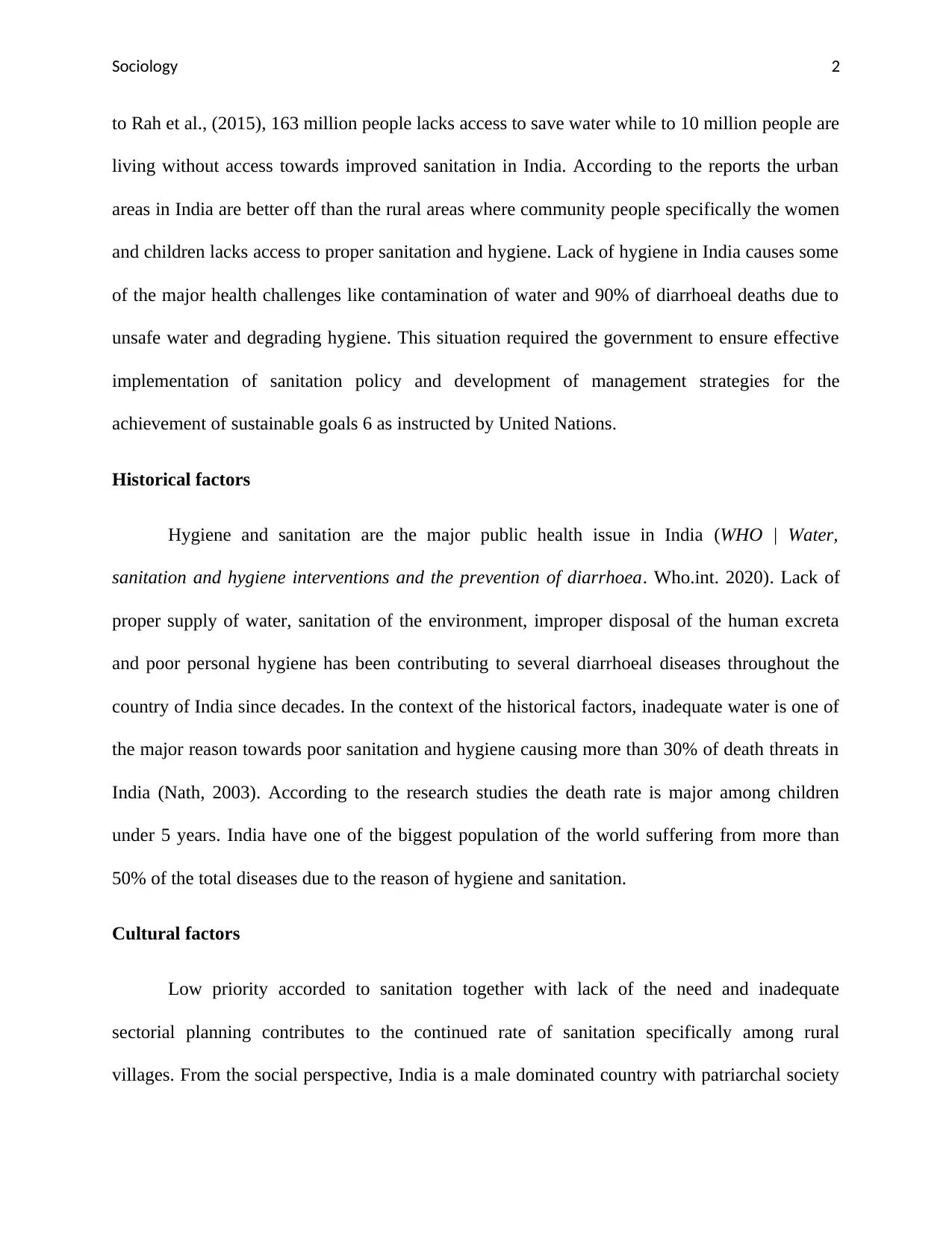
Sociology 2
to Rah et al., (2015), 163 million people lacks access to save water while to 10 million people are
living without access towards improved sanitation in India. According to the reports the urban
areas in India are better off than the rural areas where community people specifically the women
and children lacks access to proper sanitation and hygiene. Lack of hygiene in India causes some
of the major health challenges like contamination of water and 90% of diarrhoeal deaths due to
unsafe water and degrading hygiene. This situation required the government to ensure effective
implementation of sanitation policy and development of management strategies for the
achievement of sustainable goals 6 as instructed by United Nations.
Historical factors
Hygiene and sanitation are the major public health issue in India (WHO | Water,
sanitation and hygiene interventions and the prevention of diarrhoea. Who.int. 2020). Lack of
proper supply of water, sanitation of the environment, improper disposal of the human excreta
and poor personal hygiene has been contributing to several diarrhoeal diseases throughout the
country of India since decades. In the context of the historical factors, inadequate water is one of
the major reason towards poor sanitation and hygiene causing more than 30% of death threats in
India (Nath, 2003). According to the research studies the death rate is major among children
under 5 years. India have one of the biggest population of the world suffering from more than
50% of the total diseases due to the reason of hygiene and sanitation.
Cultural factors
Low priority accorded to sanitation together with lack of the need and inadequate
sectorial planning contributes to the continued rate of sanitation specifically among rural
villages. From the social perspective, India is a male dominated country with patriarchal society
to Rah et al., (2015), 163 million people lacks access to save water while to 10 million people are
living without access towards improved sanitation in India. According to the reports the urban
areas in India are better off than the rural areas where community people specifically the women
and children lacks access to proper sanitation and hygiene. Lack of hygiene in India causes some
of the major health challenges like contamination of water and 90% of diarrhoeal deaths due to
unsafe water and degrading hygiene. This situation required the government to ensure effective
implementation of sanitation policy and development of management strategies for the
achievement of sustainable goals 6 as instructed by United Nations.
Historical factors
Hygiene and sanitation are the major public health issue in India (WHO | Water,
sanitation and hygiene interventions and the prevention of diarrhoea. Who.int. 2020). Lack of
proper supply of water, sanitation of the environment, improper disposal of the human excreta
and poor personal hygiene has been contributing to several diarrhoeal diseases throughout the
country of India since decades. In the context of the historical factors, inadequate water is one of
the major reason towards poor sanitation and hygiene causing more than 30% of death threats in
India (Nath, 2003). According to the research studies the death rate is major among children
under 5 years. India have one of the biggest population of the world suffering from more than
50% of the total diseases due to the reason of hygiene and sanitation.
Cultural factors
Low priority accorded to sanitation together with lack of the need and inadequate
sectorial planning contributes to the continued rate of sanitation specifically among rural
villages. From the social perspective, India is a male dominated country with patriarchal society
⊘ This is a preview!⊘
Do you want full access?
Subscribe today to unlock all pages.

Trusted by 1+ million students worldwide
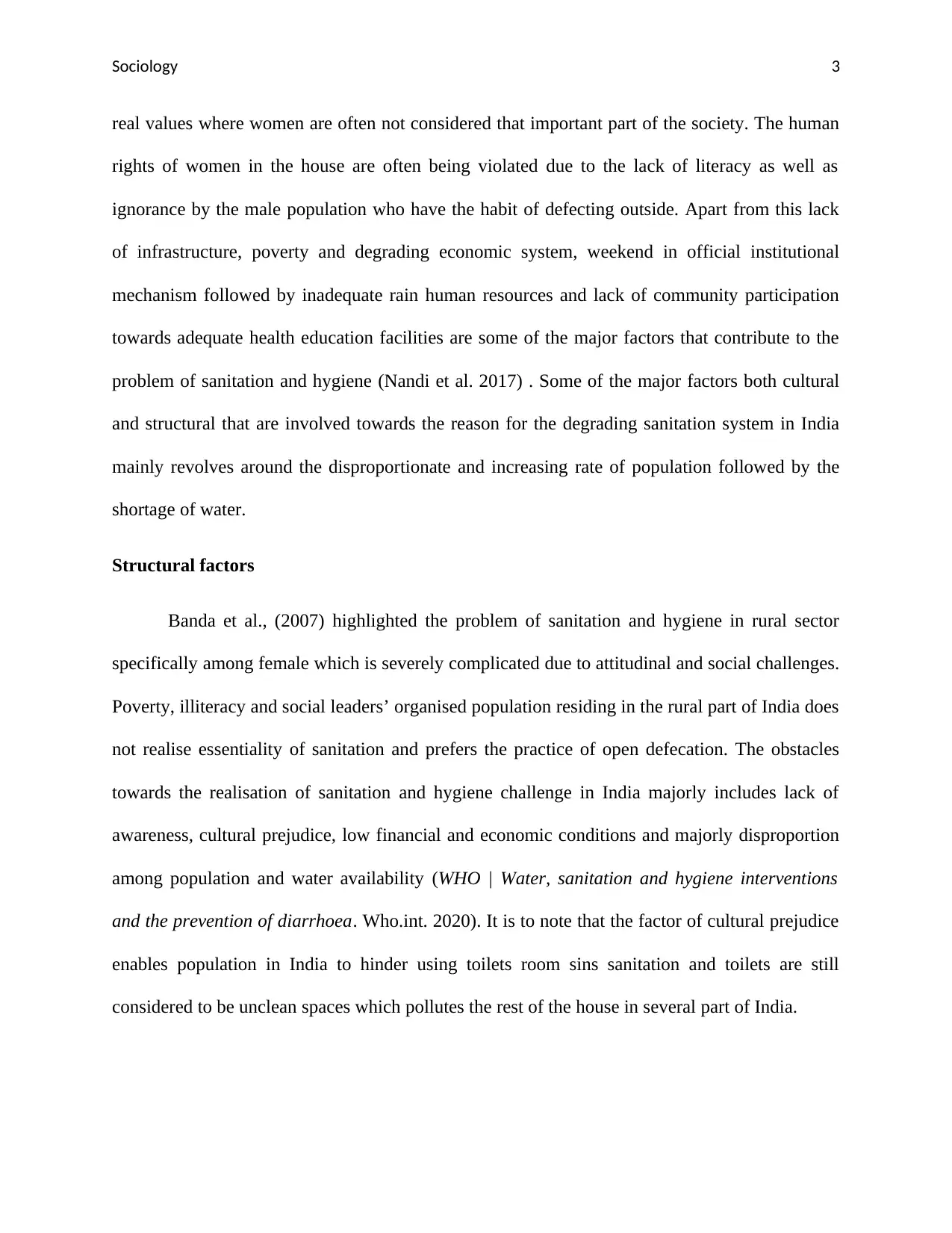
Sociology 3
real values where women are often not considered that important part of the society. The human
rights of women in the house are often being violated due to the lack of literacy as well as
ignorance by the male population who have the habit of defecting outside. Apart from this lack
of infrastructure, poverty and degrading economic system, weekend in official institutional
mechanism followed by inadequate rain human resources and lack of community participation
towards adequate health education facilities are some of the major factors that contribute to the
problem of sanitation and hygiene (Nandi et al. 2017) . Some of the major factors both cultural
and structural that are involved towards the reason for the degrading sanitation system in India
mainly revolves around the disproportionate and increasing rate of population followed by the
shortage of water.
Structural factors
Banda et al., (2007) highlighted the problem of sanitation and hygiene in rural sector
specifically among female which is severely complicated due to attitudinal and social challenges.
Poverty, illiteracy and social leaders’ organised population residing in the rural part of India does
not realise essentiality of sanitation and prefers the practice of open defecation. The obstacles
towards the realisation of sanitation and hygiene challenge in India majorly includes lack of
awareness, cultural prejudice, low financial and economic conditions and majorly disproportion
among population and water availability (WHO | Water, sanitation and hygiene interventions
and the prevention of diarrhoea. Who.int. 2020). It is to note that the factor of cultural prejudice
enables population in India to hinder using toilets room sins sanitation and toilets are still
considered to be unclean spaces which pollutes the rest of the house in several part of India.
real values where women are often not considered that important part of the society. The human
rights of women in the house are often being violated due to the lack of literacy as well as
ignorance by the male population who have the habit of defecting outside. Apart from this lack
of infrastructure, poverty and degrading economic system, weekend in official institutional
mechanism followed by inadequate rain human resources and lack of community participation
towards adequate health education facilities are some of the major factors that contribute to the
problem of sanitation and hygiene (Nandi et al. 2017) . Some of the major factors both cultural
and structural that are involved towards the reason for the degrading sanitation system in India
mainly revolves around the disproportionate and increasing rate of population followed by the
shortage of water.
Structural factors
Banda et al., (2007) highlighted the problem of sanitation and hygiene in rural sector
specifically among female which is severely complicated due to attitudinal and social challenges.
Poverty, illiteracy and social leaders’ organised population residing in the rural part of India does
not realise essentiality of sanitation and prefers the practice of open defecation. The obstacles
towards the realisation of sanitation and hygiene challenge in India majorly includes lack of
awareness, cultural prejudice, low financial and economic conditions and majorly disproportion
among population and water availability (WHO | Water, sanitation and hygiene interventions
and the prevention of diarrhoea. Who.int. 2020). It is to note that the factor of cultural prejudice
enables population in India to hinder using toilets room sins sanitation and toilets are still
considered to be unclean spaces which pollutes the rest of the house in several part of India.
Paraphrase This Document
Need a fresh take? Get an instant paraphrase of this document with our AI Paraphraser
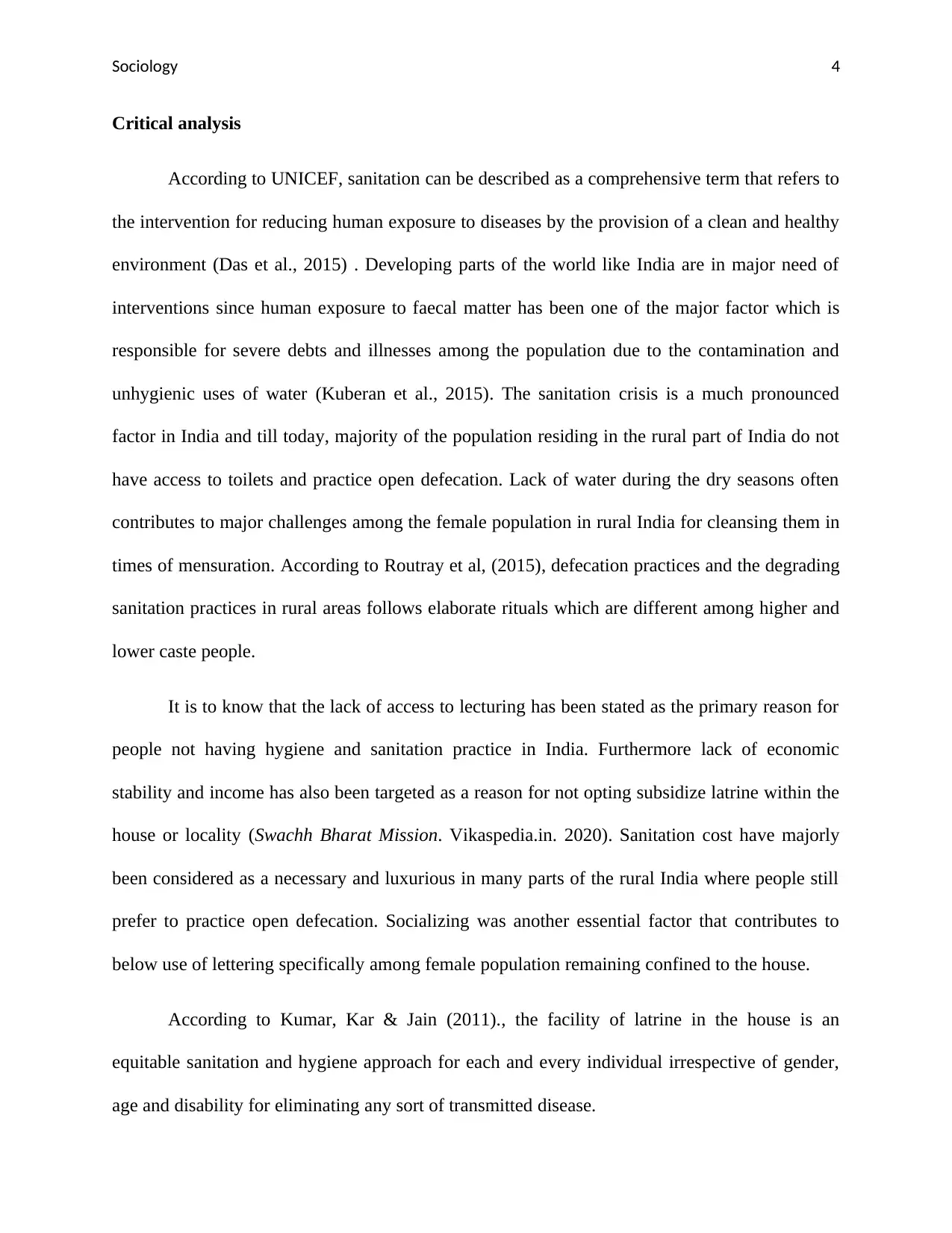
Sociology 4
Critical analysis
According to UNICEF, sanitation can be described as a comprehensive term that refers to
the intervention for reducing human exposure to diseases by the provision of a clean and healthy
environment (Das et al., 2015) . Developing parts of the world like India are in major need of
interventions since human exposure to faecal matter has been one of the major factor which is
responsible for severe debts and illnesses among the population due to the contamination and
unhygienic uses of water (Kuberan et al., 2015). The sanitation crisis is a much pronounced
factor in India and till today, majority of the population residing in the rural part of India do not
have access to toilets and practice open defecation. Lack of water during the dry seasons often
contributes to major challenges among the female population in rural India for cleansing them in
times of mensuration. According to Routray et al, (2015), defecation practices and the degrading
sanitation practices in rural areas follows elaborate rituals which are different among higher and
lower caste people.
It is to know that the lack of access to lecturing has been stated as the primary reason for
people not having hygiene and sanitation practice in India. Furthermore lack of economic
stability and income has also been targeted as a reason for not opting subsidize latrine within the
house or locality (Swachh Bharat Mission. Vikaspedia.in. 2020). Sanitation cost have majorly
been considered as a necessary and luxurious in many parts of the rural India where people still
prefer to practice open defecation. Socializing was another essential factor that contributes to
below use of lettering specifically among female population remaining confined to the house.
According to Kumar, Kar & Jain (2011)., the facility of latrine in the house is an
equitable sanitation and hygiene approach for each and every individual irrespective of gender,
age and disability for eliminating any sort of transmitted disease.
Critical analysis
According to UNICEF, sanitation can be described as a comprehensive term that refers to
the intervention for reducing human exposure to diseases by the provision of a clean and healthy
environment (Das et al., 2015) . Developing parts of the world like India are in major need of
interventions since human exposure to faecal matter has been one of the major factor which is
responsible for severe debts and illnesses among the population due to the contamination and
unhygienic uses of water (Kuberan et al., 2015). The sanitation crisis is a much pronounced
factor in India and till today, majority of the population residing in the rural part of India do not
have access to toilets and practice open defecation. Lack of water during the dry seasons often
contributes to major challenges among the female population in rural India for cleansing them in
times of mensuration. According to Routray et al, (2015), defecation practices and the degrading
sanitation practices in rural areas follows elaborate rituals which are different among higher and
lower caste people.
It is to know that the lack of access to lecturing has been stated as the primary reason for
people not having hygiene and sanitation practice in India. Furthermore lack of economic
stability and income has also been targeted as a reason for not opting subsidize latrine within the
house or locality (Swachh Bharat Mission. Vikaspedia.in. 2020). Sanitation cost have majorly
been considered as a necessary and luxurious in many parts of the rural India where people still
prefer to practice open defecation. Socializing was another essential factor that contributes to
below use of lettering specifically among female population remaining confined to the house.
According to Kumar, Kar & Jain (2011)., the facility of latrine in the house is an
equitable sanitation and hygiene approach for each and every individual irrespective of gender,
age and disability for eliminating any sort of transmitted disease.
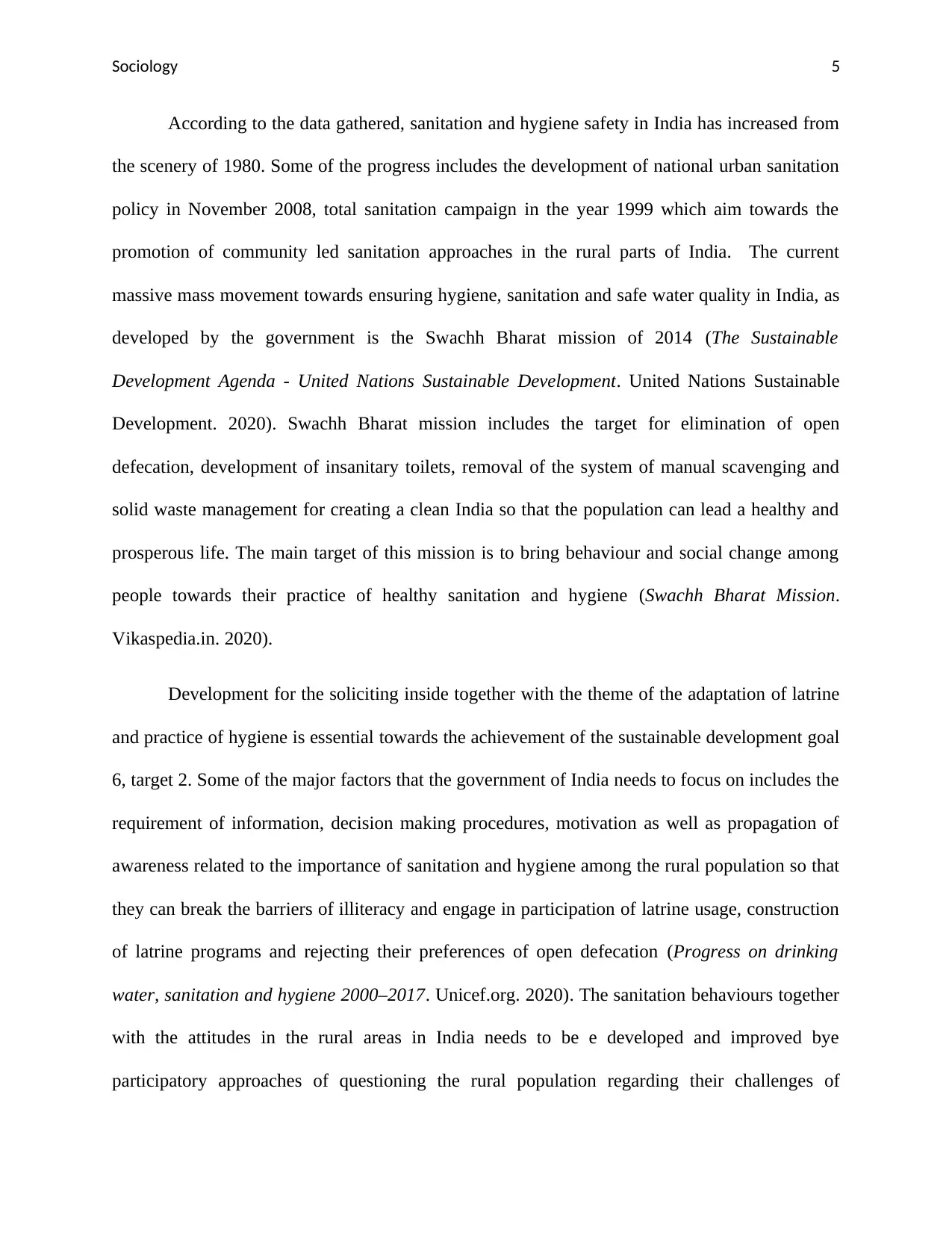
Sociology 5
According to the data gathered, sanitation and hygiene safety in India has increased from
the scenery of 1980. Some of the progress includes the development of national urban sanitation
policy in November 2008, total sanitation campaign in the year 1999 which aim towards the
promotion of community led sanitation approaches in the rural parts of India. The current
massive mass movement towards ensuring hygiene, sanitation and safe water quality in India, as
developed by the government is the Swachh Bharat mission of 2014 (The Sustainable
Development Agenda - United Nations Sustainable Development. United Nations Sustainable
Development. 2020). Swachh Bharat mission includes the target for elimination of open
defecation, development of insanitary toilets, removal of the system of manual scavenging and
solid waste management for creating a clean India so that the population can lead a healthy and
prosperous life. The main target of this mission is to bring behaviour and social change among
people towards their practice of healthy sanitation and hygiene (Swachh Bharat Mission.
Vikaspedia.in. 2020).
Development for the soliciting inside together with the theme of the adaptation of latrine
and practice of hygiene is essential towards the achievement of the sustainable development goal
6, target 2. Some of the major factors that the government of India needs to focus on includes the
requirement of information, decision making procedures, motivation as well as propagation of
awareness related to the importance of sanitation and hygiene among the rural population so that
they can break the barriers of illiteracy and engage in participation of latrine usage, construction
of latrine programs and rejecting their preferences of open defecation (Progress on drinking
water, sanitation and hygiene 2000–2017. Unicef.org. 2020). The sanitation behaviours together
with the attitudes in the rural areas in India needs to be e developed and improved bye
participatory approaches of questioning the rural population regarding their challenges of
According to the data gathered, sanitation and hygiene safety in India has increased from
the scenery of 1980. Some of the progress includes the development of national urban sanitation
policy in November 2008, total sanitation campaign in the year 1999 which aim towards the
promotion of community led sanitation approaches in the rural parts of India. The current
massive mass movement towards ensuring hygiene, sanitation and safe water quality in India, as
developed by the government is the Swachh Bharat mission of 2014 (The Sustainable
Development Agenda - United Nations Sustainable Development. United Nations Sustainable
Development. 2020). Swachh Bharat mission includes the target for elimination of open
defecation, development of insanitary toilets, removal of the system of manual scavenging and
solid waste management for creating a clean India so that the population can lead a healthy and
prosperous life. The main target of this mission is to bring behaviour and social change among
people towards their practice of healthy sanitation and hygiene (Swachh Bharat Mission.
Vikaspedia.in. 2020).
Development for the soliciting inside together with the theme of the adaptation of latrine
and practice of hygiene is essential towards the achievement of the sustainable development goal
6, target 2. Some of the major factors that the government of India needs to focus on includes the
requirement of information, decision making procedures, motivation as well as propagation of
awareness related to the importance of sanitation and hygiene among the rural population so that
they can break the barriers of illiteracy and engage in participation of latrine usage, construction
of latrine programs and rejecting their preferences of open defecation (Progress on drinking
water, sanitation and hygiene 2000–2017. Unicef.org. 2020). The sanitation behaviours together
with the attitudes in the rural areas in India needs to be e developed and improved bye
participatory approaches of questioning the rural population regarding their challenges of
⊘ This is a preview!⊘
Do you want full access?
Subscribe today to unlock all pages.

Trusted by 1+ million students worldwide
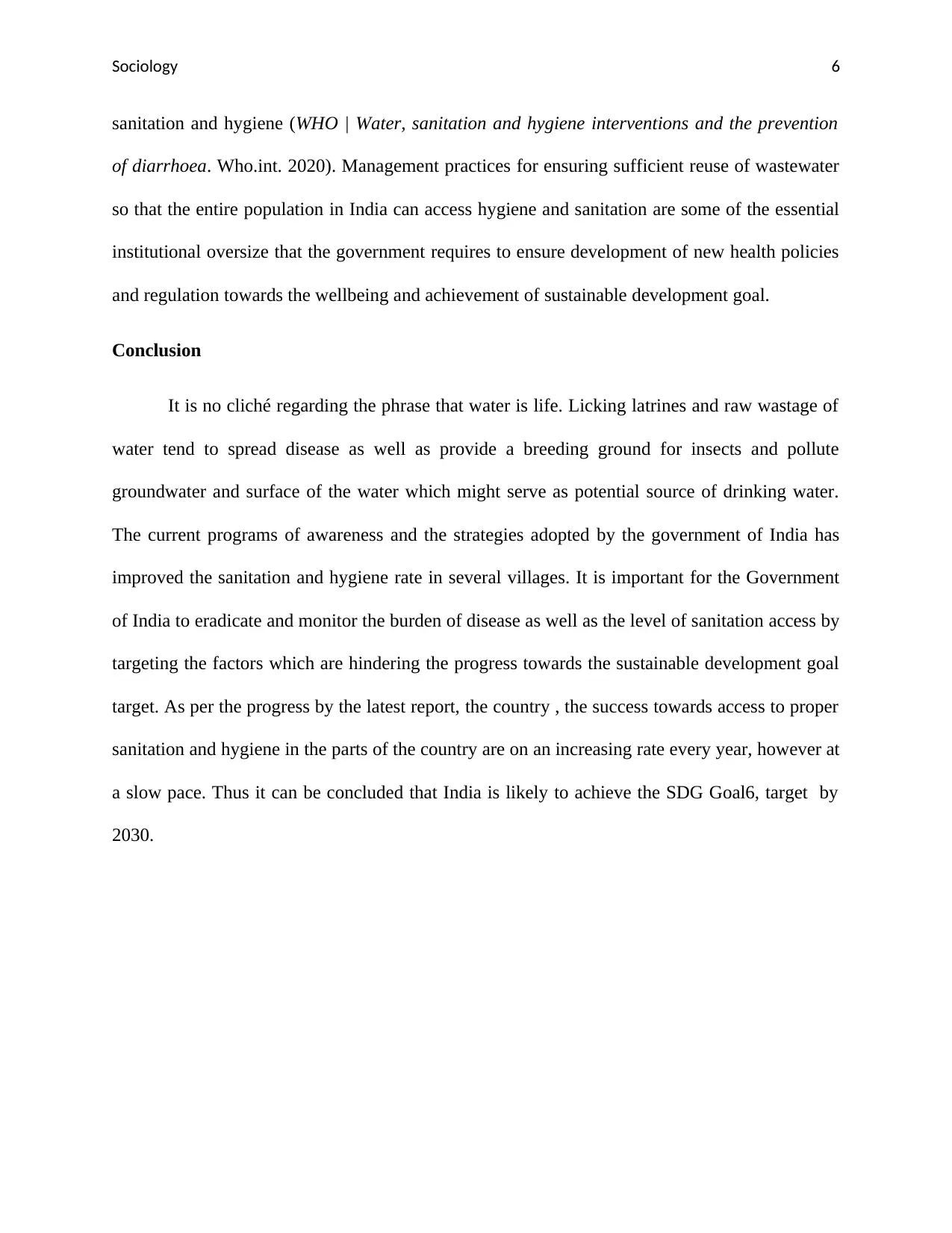
Sociology 6
sanitation and hygiene (WHO | Water, sanitation and hygiene interventions and the prevention
of diarrhoea. Who.int. 2020). Management practices for ensuring sufficient reuse of wastewater
so that the entire population in India can access hygiene and sanitation are some of the essential
institutional oversize that the government requires to ensure development of new health policies
and regulation towards the wellbeing and achievement of sustainable development goal.
Conclusion
It is no cliché regarding the phrase that water is life. Licking latrines and raw wastage of
water tend to spread disease as well as provide a breeding ground for insects and pollute
groundwater and surface of the water which might serve as potential source of drinking water.
The current programs of awareness and the strategies adopted by the government of India has
improved the sanitation and hygiene rate in several villages. It is important for the Government
of India to eradicate and monitor the burden of disease as well as the level of sanitation access by
targeting the factors which are hindering the progress towards the sustainable development goal
target. As per the progress by the latest report, the country , the success towards access to proper
sanitation and hygiene in the parts of the country are on an increasing rate every year, however at
a slow pace. Thus it can be concluded that India is likely to achieve the SDG Goal6, target by
2030.
sanitation and hygiene (WHO | Water, sanitation and hygiene interventions and the prevention
of diarrhoea. Who.int. 2020). Management practices for ensuring sufficient reuse of wastewater
so that the entire population in India can access hygiene and sanitation are some of the essential
institutional oversize that the government requires to ensure development of new health policies
and regulation towards the wellbeing and achievement of sustainable development goal.
Conclusion
It is no cliché regarding the phrase that water is life. Licking latrines and raw wastage of
water tend to spread disease as well as provide a breeding ground for insects and pollute
groundwater and surface of the water which might serve as potential source of drinking water.
The current programs of awareness and the strategies adopted by the government of India has
improved the sanitation and hygiene rate in several villages. It is important for the Government
of India to eradicate and monitor the burden of disease as well as the level of sanitation access by
targeting the factors which are hindering the progress towards the sustainable development goal
target. As per the progress by the latest report, the country , the success towards access to proper
sanitation and hygiene in the parts of the country are on an increasing rate every year, however at
a slow pace. Thus it can be concluded that India is likely to achieve the SDG Goal6, target by
2030.
Paraphrase This Document
Need a fresh take? Get an instant paraphrase of this document with our AI Paraphraser
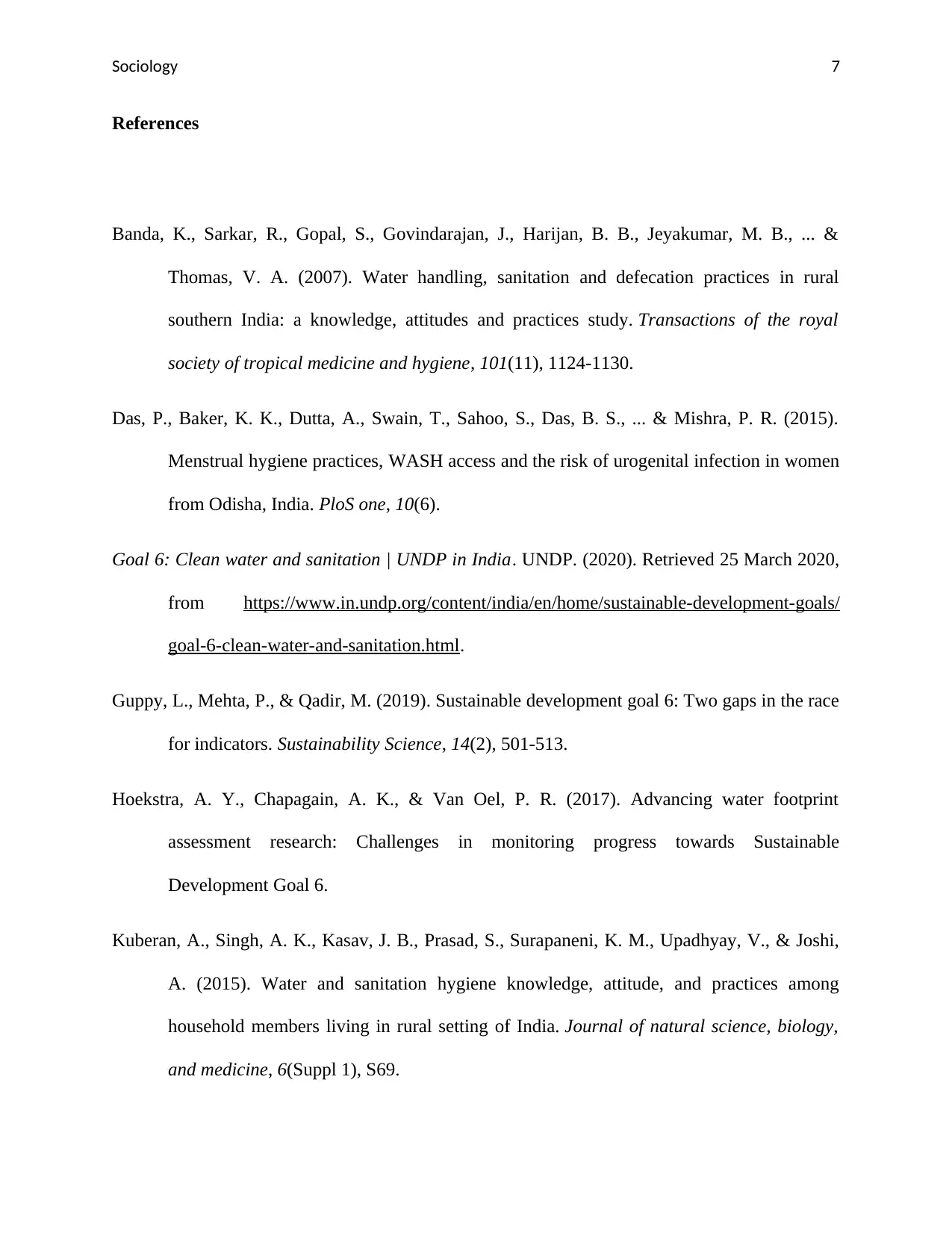
Sociology 7
References
Banda, K., Sarkar, R., Gopal, S., Govindarajan, J., Harijan, B. B., Jeyakumar, M. B., ... &
Thomas, V. A. (2007). Water handling, sanitation and defecation practices in rural
southern India: a knowledge, attitudes and practices study. Transactions of the royal
society of tropical medicine and hygiene, 101(11), 1124-1130.
Das, P., Baker, K. K., Dutta, A., Swain, T., Sahoo, S., Das, B. S., ... & Mishra, P. R. (2015).
Menstrual hygiene practices, WASH access and the risk of urogenital infection in women
from Odisha, India. PloS one, 10(6).
Goal 6: Clean water and sanitation | UNDP in India. UNDP. (2020). Retrieved 25 March 2020,
from https://www.in.undp.org/content/india/en/home/sustainable-development-goals/
goal-6-clean-water-and-sanitation.html.
Guppy, L., Mehta, P., & Qadir, M. (2019). Sustainable development goal 6: Two gaps in the race
for indicators. Sustainability Science, 14(2), 501-513.
Hoekstra, A. Y., Chapagain, A. K., & Van Oel, P. R. (2017). Advancing water footprint
assessment research: Challenges in monitoring progress towards Sustainable
Development Goal 6.
Kuberan, A., Singh, A. K., Kasav, J. B., Prasad, S., Surapaneni, K. M., Upadhyay, V., & Joshi,
A. (2015). Water and sanitation hygiene knowledge, attitude, and practices among
household members living in rural setting of India. Journal of natural science, biology,
and medicine, 6(Suppl 1), S69.
References
Banda, K., Sarkar, R., Gopal, S., Govindarajan, J., Harijan, B. B., Jeyakumar, M. B., ... &
Thomas, V. A. (2007). Water handling, sanitation and defecation practices in rural
southern India: a knowledge, attitudes and practices study. Transactions of the royal
society of tropical medicine and hygiene, 101(11), 1124-1130.
Das, P., Baker, K. K., Dutta, A., Swain, T., Sahoo, S., Das, B. S., ... & Mishra, P. R. (2015).
Menstrual hygiene practices, WASH access and the risk of urogenital infection in women
from Odisha, India. PloS one, 10(6).
Goal 6: Clean water and sanitation | UNDP in India. UNDP. (2020). Retrieved 25 March 2020,
from https://www.in.undp.org/content/india/en/home/sustainable-development-goals/
goal-6-clean-water-and-sanitation.html.
Guppy, L., Mehta, P., & Qadir, M. (2019). Sustainable development goal 6: Two gaps in the race
for indicators. Sustainability Science, 14(2), 501-513.
Hoekstra, A. Y., Chapagain, A. K., & Van Oel, P. R. (2017). Advancing water footprint
assessment research: Challenges in monitoring progress towards Sustainable
Development Goal 6.
Kuberan, A., Singh, A. K., Kasav, J. B., Prasad, S., Surapaneni, K. M., Upadhyay, V., & Joshi,
A. (2015). Water and sanitation hygiene knowledge, attitude, and practices among
household members living in rural setting of India. Journal of natural science, biology,
and medicine, 6(Suppl 1), S69.
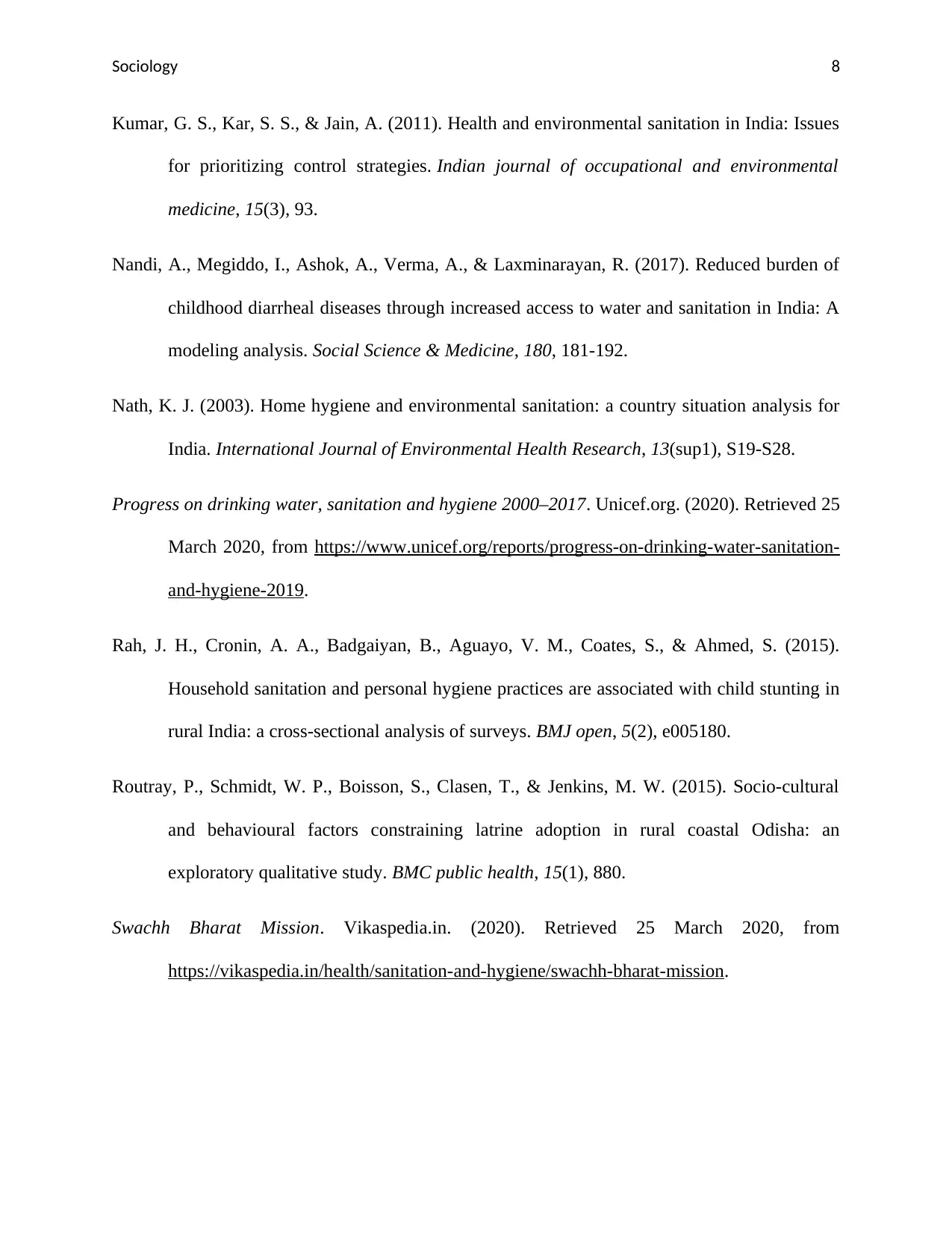
Sociology 8
Kumar, G. S., Kar, S. S., & Jain, A. (2011). Health and environmental sanitation in India: Issues
for prioritizing control strategies. Indian journal of occupational and environmental
medicine, 15(3), 93.
Nandi, A., Megiddo, I., Ashok, A., Verma, A., & Laxminarayan, R. (2017). Reduced burden of
childhood diarrheal diseases through increased access to water and sanitation in India: A
modeling analysis. Social Science & Medicine, 180, 181-192.
Nath, K. J. (2003). Home hygiene and environmental sanitation: a country situation analysis for
India. International Journal of Environmental Health Research, 13(sup1), S19-S28.
Progress on drinking water, sanitation and hygiene 2000–2017. Unicef.org. (2020). Retrieved 25
March 2020, from https://www.unicef.org/reports/progress-on-drinking-water-sanitation-
and-hygiene-2019.
Rah, J. H., Cronin, A. A., Badgaiyan, B., Aguayo, V. M., Coates, S., & Ahmed, S. (2015).
Household sanitation and personal hygiene practices are associated with child stunting in
rural India: a cross-sectional analysis of surveys. BMJ open, 5(2), e005180.
Routray, P., Schmidt, W. P., Boisson, S., Clasen, T., & Jenkins, M. W. (2015). Socio-cultural
and behavioural factors constraining latrine adoption in rural coastal Odisha: an
exploratory qualitative study. BMC public health, 15(1), 880.
Swachh Bharat Mission. Vikaspedia.in. (2020). Retrieved 25 March 2020, from
https://vikaspedia.in/health/sanitation-and-hygiene/swachh-bharat-mission.
Kumar, G. S., Kar, S. S., & Jain, A. (2011). Health and environmental sanitation in India: Issues
for prioritizing control strategies. Indian journal of occupational and environmental
medicine, 15(3), 93.
Nandi, A., Megiddo, I., Ashok, A., Verma, A., & Laxminarayan, R. (2017). Reduced burden of
childhood diarrheal diseases through increased access to water and sanitation in India: A
modeling analysis. Social Science & Medicine, 180, 181-192.
Nath, K. J. (2003). Home hygiene and environmental sanitation: a country situation analysis for
India. International Journal of Environmental Health Research, 13(sup1), S19-S28.
Progress on drinking water, sanitation and hygiene 2000–2017. Unicef.org. (2020). Retrieved 25
March 2020, from https://www.unicef.org/reports/progress-on-drinking-water-sanitation-
and-hygiene-2019.
Rah, J. H., Cronin, A. A., Badgaiyan, B., Aguayo, V. M., Coates, S., & Ahmed, S. (2015).
Household sanitation and personal hygiene practices are associated with child stunting in
rural India: a cross-sectional analysis of surveys. BMJ open, 5(2), e005180.
Routray, P., Schmidt, W. P., Boisson, S., Clasen, T., & Jenkins, M. W. (2015). Socio-cultural
and behavioural factors constraining latrine adoption in rural coastal Odisha: an
exploratory qualitative study. BMC public health, 15(1), 880.
Swachh Bharat Mission. Vikaspedia.in. (2020). Retrieved 25 March 2020, from
https://vikaspedia.in/health/sanitation-and-hygiene/swachh-bharat-mission.
⊘ This is a preview!⊘
Do you want full access?
Subscribe today to unlock all pages.

Trusted by 1+ million students worldwide

Sociology 9
The Sustainable Development Agenda - United Nations Sustainable Development. United
Nations Sustainable Development. (2020). Retrieved 25 March 2020, from
https://www.un.org/sustainabledevelopment/development-agenda/.
WHO | Water, sanitation and hygiene interventions and the prevention of diarrhoea. Who.int.
(2020). Retrieved 25 March 2020, from
https://www.who.int/elena/titles/bbc/wsh_diarrhoea/en/.
The Sustainable Development Agenda - United Nations Sustainable Development. United
Nations Sustainable Development. (2020). Retrieved 25 March 2020, from
https://www.un.org/sustainabledevelopment/development-agenda/.
WHO | Water, sanitation and hygiene interventions and the prevention of diarrhoea. Who.int.
(2020). Retrieved 25 March 2020, from
https://www.who.int/elena/titles/bbc/wsh_diarrhoea/en/.
1 out of 10
Related Documents
Your All-in-One AI-Powered Toolkit for Academic Success.
+13062052269
info@desklib.com
Available 24*7 on WhatsApp / Email
![[object Object]](/_next/static/media/star-bottom.7253800d.svg)
Unlock your academic potential
Copyright © 2020–2025 A2Z Services. All Rights Reserved. Developed and managed by ZUCOL.





